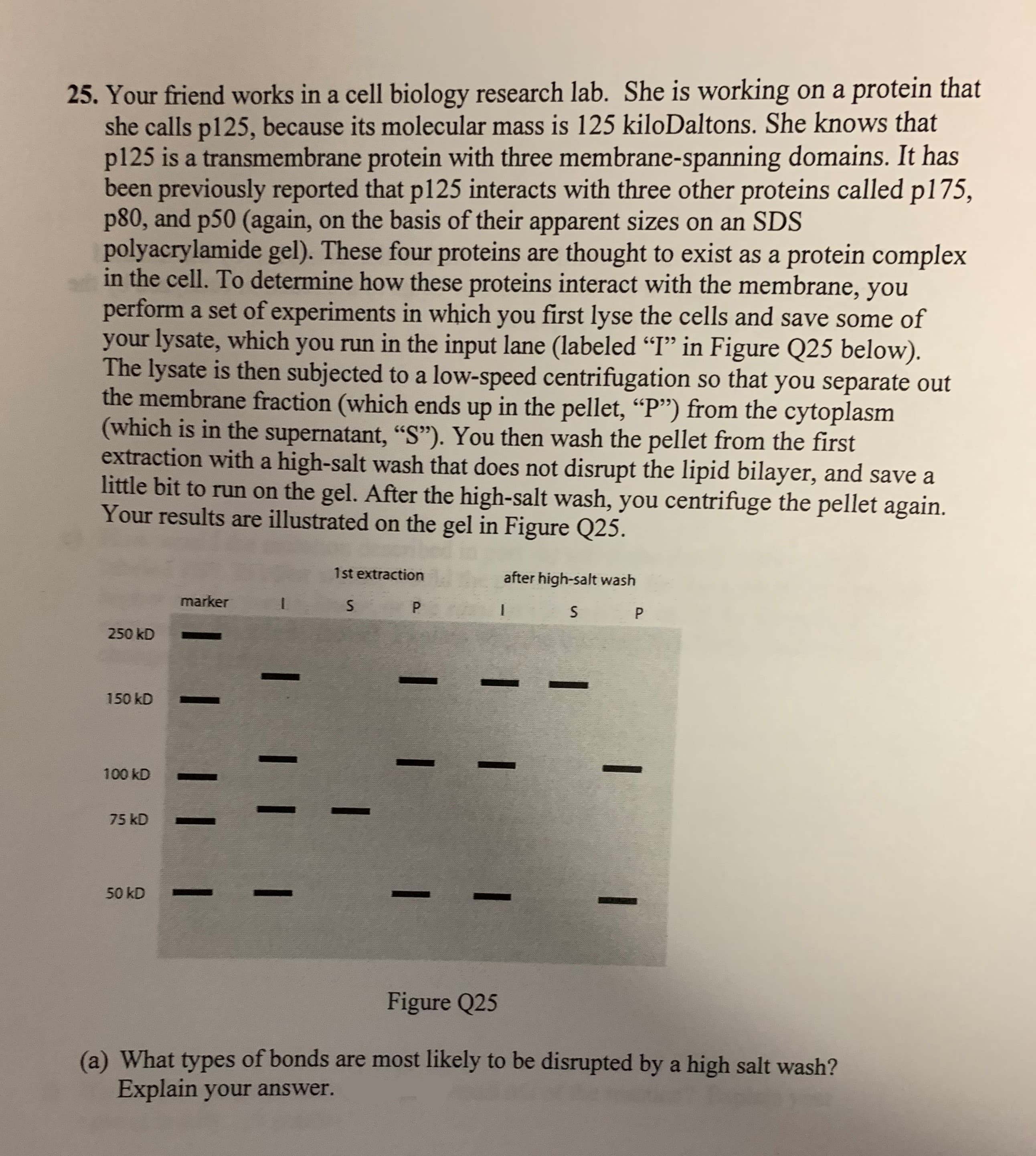25. Your friend works in a cell biology research lab. She is working she calls p125, because its molecular mass is 125 kiloDaltons. She knows that p125 is a transmembrane protein with three membrane-spanning domains. It has been previously reported that p125 interacts with three other proteins called p175, p80, and p50 (again, polyacrylamide gel). These four proteins in the cell. To determine how these proteins interact with the membrane, you perform a set of experiments in which you first lyse the cells and save some of your lysate, which you run in the input lane (labeled "I" in Figure Q25 below). The lysate is then subjected to a low-speed centrifugation so that you separate out the membrane fraction (which ends up in the pellet, "P") from the cytoplasm (which is in the supernatant, "S"). You then wash the pellet from the first extraction with a high-salt wash that does not disrupt the lipid bilayer, and save a little bit to run on the gel. After the high-salt wash, you centrifuge the pellet again. Your results are illustrated on the gel in Figure Q25. protein that on a on the basis of their apparent sizes on an SDS thought to exist as a protein complex 1st extraction after high-salt wash marker S P P 250 kD 150 kD 100 kD 75 kD 50 kD Figure Q25 (a) What types of bonds are most likely to be disrupted by a high salt wash? Explain your answer. I I 1 I | |
25. Your friend works in a cell biology research lab. She is working she calls p125, because its molecular mass is 125 kiloDaltons. She knows that p125 is a transmembrane protein with three membrane-spanning domains. It has been previously reported that p125 interacts with three other proteins called p175, p80, and p50 (again, polyacrylamide gel). These four proteins in the cell. To determine how these proteins interact with the membrane, you perform a set of experiments in which you first lyse the cells and save some of your lysate, which you run in the input lane (labeled "I" in Figure Q25 below). The lysate is then subjected to a low-speed centrifugation so that you separate out the membrane fraction (which ends up in the pellet, "P") from the cytoplasm (which is in the supernatant, "S"). You then wash the pellet from the first extraction with a high-salt wash that does not disrupt the lipid bilayer, and save a little bit to run on the gel. After the high-salt wash, you centrifuge the pellet again. Your results are illustrated on the gel in Figure Q25. protein that on a on the basis of their apparent sizes on an SDS thought to exist as a protein complex 1st extraction after high-salt wash marker S P P 250 kD 150 kD 100 kD 75 kD 50 kD Figure Q25 (a) What types of bonds are most likely to be disrupted by a high salt wash? Explain your answer. I I 1 I | |
Biology 2e
2nd Edition
ISBN:9781947172517
Author:Matthew Douglas, Jung Choi, Mary Ann Clark
Publisher:Matthew Douglas, Jung Choi, Mary Ann Clark
Chapter5: Structure And Function Of Plasma Membranes
Section: Chapter Questions
Problem 7RQ: A scientist compares the plasma membrane composition of an animal from the Mediterranean coast with...
Related questions
Question
100%

Transcribed Image Text:25. Your friend works in a cell biology research lab. She is working
she calls p125, because its molecular mass is 125 kiloDaltons. She knows that
p125 is a transmembrane protein with three membrane-spanning domains. It has
been previously reported that p125 interacts with three other proteins called p175,
p80, and p50 (again,
polyacrylamide gel). These four proteins
in the cell. To determine how these proteins interact with the membrane, you
perform a set of experiments in which you first lyse the cells and save some of
your lysate, which you run in the input lane (labeled "I" in Figure Q25 below).
The lysate is then subjected to a low-speed centrifugation so that you separate out
the membrane fraction (which ends up in the pellet, "P") from the cytoplasm
(which is in the supernatant, "S"). You then wash the pellet from the first
extraction with a high-salt wash that does not disrupt the lipid bilayer, and save a
little bit to run on the gel. After the high-salt wash, you centrifuge the pellet again.
Your results are illustrated on the gel in Figure Q25.
protein that
on a
on the basis of their apparent sizes on an SDS
thought to exist as a
protein complex
1st extraction
after high-salt wash
marker
S
P
P
250 kD
150 kD
100 kD
75 kD
50 kD
Figure Q25
(a) What types of bonds are most likely to be disrupted by a high salt wash?
Explain your answer.
I
I
1
I | |
Expert Solution
This question has been solved!
Explore an expertly crafted, step-by-step solution for a thorough understanding of key concepts.
This is a popular solution!
Trending now
This is a popular solution!
Step by step
Solved in 2 steps

Recommended textbooks for you

Biology 2e
Biology
ISBN:
9781947172517
Author:
Matthew Douglas, Jung Choi, Mary Ann Clark
Publisher:
OpenStax

Anatomy & Physiology
Biology
ISBN:
9781938168130
Author:
Kelly A. Young, James A. Wise, Peter DeSaix, Dean H. Kruse, Brandon Poe, Eddie Johnson, Jody E. Johnson, Oksana Korol, J. Gordon Betts, Mark Womble
Publisher:
OpenStax College

Biology 2e
Biology
ISBN:
9781947172517
Author:
Matthew Douglas, Jung Choi, Mary Ann Clark
Publisher:
OpenStax

Anatomy & Physiology
Biology
ISBN:
9781938168130
Author:
Kelly A. Young, James A. Wise, Peter DeSaix, Dean H. Kruse, Brandon Poe, Eddie Johnson, Jody E. Johnson, Oksana Korol, J. Gordon Betts, Mark Womble
Publisher:
OpenStax College